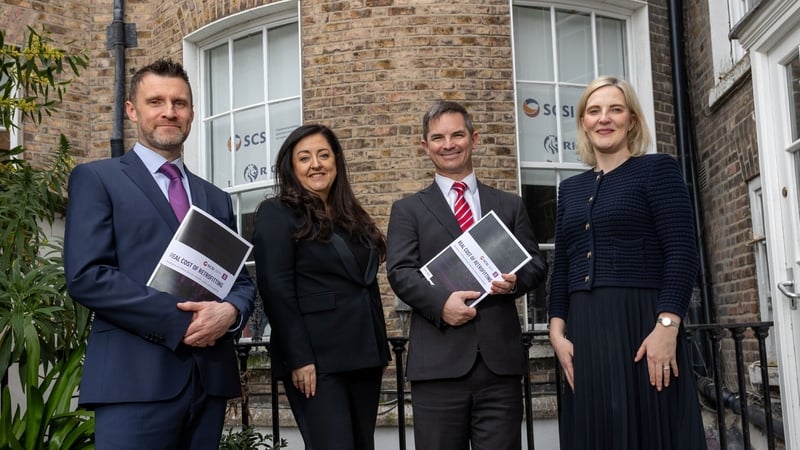Retrofitting old offices could boost rental income by up to 66%, a new survey by the Society of Chartered Surveyors Ireland and AIB suggests .
But the survey cautions that retrofits may not be viable in many cases, as the cost of the upgrades would be greater than the resulting increase in the building’s value.
SCSI also warns that growing demand for efficient offices, as well as legislative changes, means those who fail to undertake upgrades risk being left with unoccupiable premises.
The SCSI’s Real Cost of Retrofitting Offices Report 2025 aims to improve the understanding of the works that would be needed to achieve a more energy-efficient and decarbonised building stock.
This is the first research of its kind, the SCSI said, adding that further studies will be needed to ascertain the supports required to enable the delivery of Ireland Net Zero targets in the Commercial Property sector.
It said that after evaluating seven diverse commercial retrofit case studies encompassing a range of office types and conditions in Dublin, a panel of chartered valuation surveyors found that retrofitting would only be financially viable in three cases without value added elements.
The analysis found the remaining four did not meet the required viability threshold when other value add elements were excluded because the retrofit costs exceeded the anticipated increase in the building’s value.
Chartered Valuation Surveyor and co-author of the report, Sarah Garry, said the new research highlights a significant disparity between the progress in residential and commercial retrofitting.
“While the residential sector is responding more positively to energy upgrade targets, the commercial sector lags considerably. According to the CSO, almost 60% of offices having a Building Energy Ratings (BER) of D1 or lower,” Ms Garry said.
“Services encompassing mechanical and electrical upgrades which cover lighting, heating and ventilation, often represented the most significant cost component in retrofit projects. The proportion of these costs ranged between 21% and 76%. Our findings indicate that not all significant service investments resulted in an improved BER,” she said.
She said that unless owners of poor performing commercial buildings with low BER ratings can find a route to retrofitting they face the risk of their assets becoming stranded and unoccupiable.

“On the other hand, by retrofitting the property, they can improve income level from the asset – in some cases the increase in rental income ranged between 40% to 66% – increase its capital value and secure its future. In addition to the sustainable benefits there are also many social benefits in preventing vacancy and improving the vibrancy and appeal of the area,” she added.
Chartered Quantity Surveyor and co-author of today’s report, Anthony Cloonan, said the fact that retrofitting would only be financially viable in three of the seven case studies highlights the scale of the challenge facing property owners.
“Our examination of the seven case studies revealed substantial variations in retrofitting costs, largely influenced by the specific characteristics of each office block and the extent of the upgrade works,” he said.
“The findings also underscore the necessity for tailored case-by-case assessments, the importance of setting clear, strategic objectives for each project and the need to prioritise capital expenditure based on each property’s specific condition. By doing this it should be possible to make the investment cost neutral, at the minimum in most cases,” he added.
Mary Whitelaw, AIB Chief Strategy and Sustainability Officer, said today’s report marked an important first step in understanding the financial challenges associated with retrofitting office buildings and would facilitate a more proactive approach to it.
“The UN has estimated that nearly 40% of global carbon dioxide emissions come from real estate. Retrofitting existing buildings reduces the whole life carbon of a structure by not adding to the carbon already embodied in them,” she noted.
The SCSI’s Real Cost of Retrofitting Offices Report’s findings
The report mainly focused on “hard costs” which are the direct expenses related to the physical work of the retrofit itself. These costs typically cover works such as necessary part demolitions, structural repairs and upgrades to the building’s exterior walls and roofs.
The case studies excluded soft costs such as site costs, finance costs and professional fees as well as any value engineering aspects of works such as extensions or additional floors.
The first group of offices covered four office buildings in good condition located in Dublin and aged between 20 and 35 years old.
It found the cost of retrofits ranged between €225/m2 – €1,814/m2. Despite the strong opinion of improving rental and valuation metrics, only two of the property retrofits were deemed to be financially viable – that is the estimated uplift in its value would cover the cost of the retrofit.
The next group included two offices in fair condition, situated in Dublin and aged between 25 and 60 years old.
Here the cost of retrofits ranged from €917/m2 – €1,154/m2.
The analysis suggests potential economies of scale for larger properties when considering cost per square metre. While services remained a key cost factor, upgrades to the external enclosures also played a crucial role in achieving the enhanced BER rating in these cases. A retrofit was viable for one of the buildings.
The third type of building was a 40-year-old building in Dublin in poor condition which incurred a retrofitting cost of €1,462/m2, the third highest among the case studies.
This reflected the elevated prices for the external enclosure, services and internal finishes required to meet basic fit out standards. The retrofit was not deemed viable.



